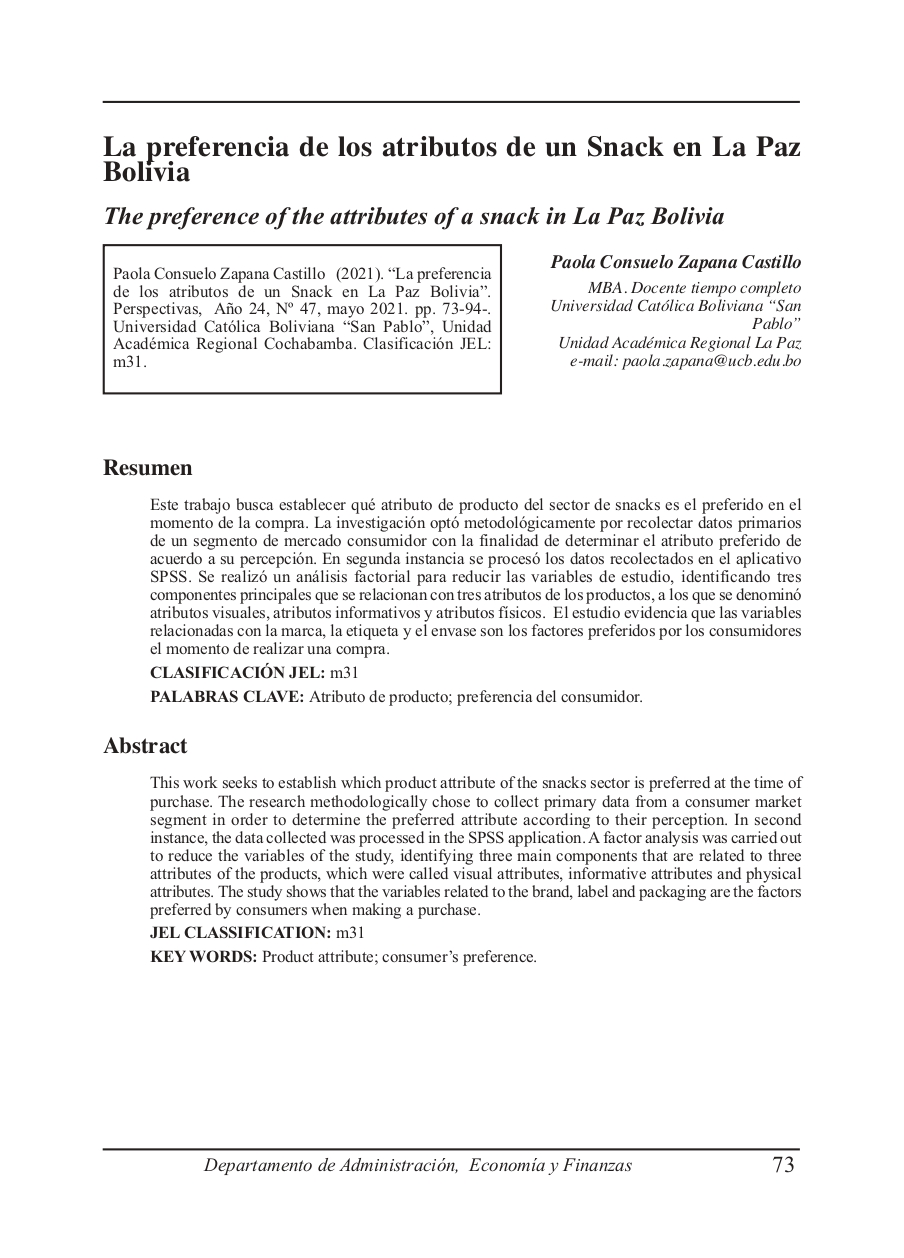The preference of the attributes of a snack in La Paz Bolivia
DOI:
https://doi.org/10.35319/aznk9g42Keywords:
Product attribute, Consumer’s preferenceAbstract
This work seeks to establish which product attribute of the snacks sector is preferred at the time of purchase. The research methodologically chose to collect primary data from a consumer market segment in order to determine the preferred attribute according to their perception. In second instance, the data collected was processed in the SPSS application. A factor analysis was carried out to reduce the variables of the study, identifying three main components that are related to three attributes of the products, which were called visual attributes, informative attributes and physical attributes. The study shows that the variables related to the brand, label and packaging are the factors preferred by consumers when making a purchase.
Downloads
References
Andrade, B., Rivera, M., & Lora Guzmán, H. (2018). El empaque como oportunidad para el desarrollo del producto y el consumidor responsable; una mirada desde la industria en Norteamérica y Suramérica. Saber, ciencia y libertad, 164–179.
Carrete, L., Arroyo, P., & Centeno, E. (2018). ¿Es la extensión de marca para productos saludables una estrategia adecuada cuando hay una alta asociación de la marca con productos no saludables? Revista Basileira de Gestão e Negócios, 421–442.
Chaplin, K., & Smith, A. (2011). Definitions and perceptions of snacking. Nutraceutical Research, 53–59.
Darren D., S., Timothy J., B., & William G., M. (2016). Food product labeling basics. Food technology fact sheet, 140–144.
Devendorf, M., & Kemper, L. (2010). Designing a product package platform. Designing a product package platform. Montréal, Quebec: ASME.
Guerrero Valenzuela, M., Hernandis Ortuño, B., & Agudo Vicente, B. (2017). Aproximación a la representación de la forma y apariencia del producto: estudio sobre los atributos de diseño. Innovar, 25–39.
Guidi, F. A., & Mamani, R. P. (2001). Características de la cadena agroalimentaria de la papa y su industrialización en Bolivia. Cochabamba: Fundación PROINPA – Proyecto papa andina.
Hess, J., & Slavin, J. (2018). The benefits of defining “snacks.” Physiology & Behavior.
Hess, J., Jonnalagadda, S., & Slavin, J. (2016). What is a Snack, why do we snack, and how can we choose better snacks? A review of the definitions of snacking, motivations to snack, contributions to dietary intake, and recommendations for improvement. American Society of Nutrition, 466–475.
Kotler, P., & Armstrong, G. (2013). Fundamentos de marketing (11.ª ed.). México: Pearson Educación.
Kotler, P., & Keller, K. (2012). Dirección de marketing (14.ª ed.). México: Pearson Educación.
Lamb, C., Hair, J., & Carl, M. (2014). MKTG. Marketing (7.ª ed.). México, D.F.: Cengage Learning.
Lambin, J.-J., Gallucci, C., & Sicurello, C. (2009). Dirección de marketing. Gestión estratégica y operativa del mercado (2.ª ed.). México, D.F.: McGraw Hill.
López Ortiz, N. (2014). El gusto por el sabor salado. Perspectivas en nutrición humana, 99–109.
Mohammad, S., & Ali, A. (2019). The relationship between consumer brand identification and brand extension. Journal of Relationship Marketing.
Rodríguez Sauceda, R., Rojo Martínez, G., Martínez Ruiz, R., Piña Ruiz, H., Ramírez Valverde, B., Vaquera Huerta, H., & Cong Hermida, M. (2014). Envases inteligentes para la conservación de alimentos. Ra Ximhai, 151–173.
Organización Panamericana de Salud. (2015). Alimentos y bebidas ultraprocesados en América Latina.
Puma Isuiza, G., & Núñez Saavedra, C. (2018). Determinación del perfil de textura sensorial de dos muestras experimentales de hot dog de pollo (Gallus gallus) obtenidas por Ingeniería Kansei Tipo II. Anales científicos, 210–217.
Rodríguez, M., & Mora, R. (2001). Análisis factorial. En Estadística informática: casos y ejemplos con el SPSS (pp. 127–142).
Rosenthal, A. (2010). Textura de los alimentos. México.
Sáez, A., Aponte, B., & Castellano, S. (2009). Preferencias del consumidor de embutidos en el municipio Maracaibo del Estado Zulia, Venezuela. Agroalimentaria, 55–67.
Stanton, W., Etzel, M., & Walker, B. (2007). Fundamentos de Marketing. México, D.F.: McGraw Hill Interamericana.

Downloads
Published
Issue
Section
License
Copyright (c) 2021 Revista Perspectivas

This work is licensed under a Creative Commons Attribution-NonCommercial-ShareAlike 4.0 International License.
La Revista Perspectivas de la Universidad Católica Boliviana, es una revista de acceso abierto, por lo tanto, es de libre acceso en su integridad. Está permitida su lectura, búsqueda, descarga, distribución y reutilización legal en cualquier tipo de soporte únicamente para fines no comerciales, siempre y cuando la obra sea debidamente citada.




